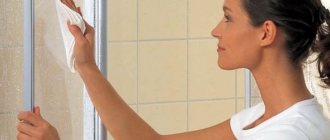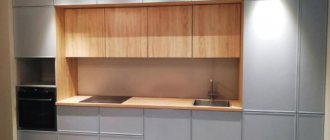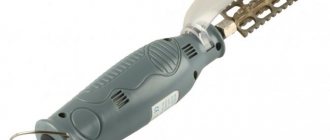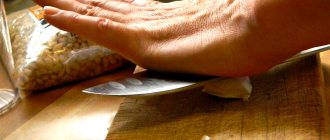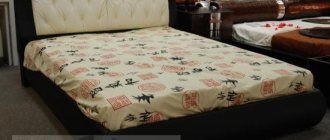This article describes how to properly care for nickel-plated and chrome-plated surfaces of various interior items and plumbing fixtures.
Nickel and chrome plating of various interior items and sanitary ware is rightfully considered one of the most practical and, with proper care, can serve for many years. It is thanks to its practicality and low cost that many household items have this coating - it could be a bathtub faucet, a door handle or furniture accessories. To ensure that such products do not fade over time and remain in good condition for a long time, you need to know how to properly care for them.
The first thing to keep in mind is that under no circumstances should you use any hard abrasive substances or use iron brushes or sandpaper when cleaning nickel and chrome plated surfaces. This leads to damage to the surface, leaving scratches.
In addition, it must be taken into account that the use of acid-containing substances, solvents, and various means for removing limescale is also unacceptable. Otherwise, we will not get a shiny, mirror-like surface, but a dull and darkened one.
What should you use to clean these surfaces? Of course, in the first place are branded, specially developed product care products with a nickel-plated and chrome-plated surface. But you can also use simpler products, but with a composition that implies the presence of soft or fine abrasives, organic solvents, ammonia, and wax. All this can be read on the label of the cleaning product manufacturer.
The most common, so to speak “at-home” method of cleaning a chrome surface is carried out using a soft cloth and a warm soapy solution. Moreover, if limescale has formed on the surface, you can get rid of it with the help of grape vinegar.
To clean nickel-plated surfaces, special pastes and liquid products are used, as well as regular chalk or a solution prepared in this way: add one teaspoon of salt to one tablespoon of vinegar.
Rust from a nickel-plated product can be easily removed using fat using the following method: you need to apply any animal or fish oil to the rust spots, and after a couple of days, thoroughly wipe the product with a soft cloth soaked in ammonia.
When using various purchased products to clean products, you should not leave them in contact with the surface for a long period of time; you must thoroughly rinse them with water after application after the time specified in the instructions.
Finally, it should be noted that the nickel-plated and chrome-plated surface must be cleaned as often as possible, without waiting for it to become “overgrown” with dirt and oxidation, and then it will last much longer.
The samovar is a symbol of Russian tea drinking, which used to be very popular. Nowadays it is not served on the table so often, but it is still considered that such tea is especially tasty and rich.
How to remove rust from metal?
Remove rust from metal using vinegar
- Instruments must be completely immersed in a small container with undiluted 9% vinegar for 24 hours. ...
- Lubricate an object with a large area of damage generously with vinegar, leave for a while to soften the plaque, and then brush over the metal.
25 Jan
2022 Interesting materials:
How to clean a rabbit fur coat from yellowness? How to clean a sheepskin coat? How to clean an arctic fox fur coat? How to clean a light muton fur coat? How to clean the grout between tiles? How to clean tile grout in the bathroom? How to clean a siphon under a bathtub? How to clean a silicone phone case? How to clean a silicone case from yellowness? How to clean a silicone case?
Pros of nickel-plated cookware
- Durability is the main advantage of nickel cookware. If treated appropriately, it has the potential to serve for decades.
- Hygiene. The main difference between nickel-plated cookware is that it is actually quite possible to call it hygienic, since harmful microbes do not accumulate on the smooth polished surface.
- Nickel cookware is environmentally friendly and can be recycled.
- Durability: such dishes are considered strong and not prone to various cracks and dents, and they can also be used on various stoves.
- Convenient use: does not require labor-intensive care, cleans easily and quickly.
Let's look further at how and how to clean nickel-plated cookware. Our tips will help you cope with the task easily.
How to Clean Stainless Steel Cutlery
Stainless steel, practical in all respects, is most often found in the kitchen. Not only spoons, forks and knives are made from this material, but also ladle, spatulas and other kitchen utensils.
- The most common way to clean stainless steel cutlery is with a solution of soda and salt. Pour 1 liter of hot water into a deep enough metal container and add 1 tbsp. l. baking soda and salt. Mix thoroughly until the dry particles are completely dissolved. Place a sheet of foil (shiny side up) at the bottom of the container with the solution. Immerse cutlery in the solution on top of the foil so that the liquid completely covers them, and put on fire. After the solution boils, turn the heat to low and leave it there for 15-20 minutes. After this, turn off the burner, but do not remove the container from it, let it cool. When the solution has cooled enough for your hands to bear the temperature, remove the cleaned utensils, rinse them in hot running water and wipe dry with a soft towel.
- An equally traditional method for cleaning stainless steel cutlery at home is toothpowder or toothpaste (not gel!). Unlike the previous method, here you will have to work a lot with your hands. Soak all cutlery in a bowl of hot water. Apply a little paste or powder to a soft toothbrush (the powder can first be diluted in a small cup with warm water until it becomes thick with sour cream). Now, one at a time, take the devices out of the water and clean them with a brush, especially carefully working on the raised areas. At the end of cleaning, rinse any remaining paste or powder with warm water and wipe each device dry.
- Similar to tooth powder, baking soda is used to clean stainless steel cutlery. It effectively removes brown deposits from steel. To clean, dilute baking soda with warm water in a concentration of 3:1 (you will get a paste with a consistency similar to mustard). Apply a small amount of paste to a sponge or soft cloth and wipe the spoons and forks with it until the coating disappears. Finally, rinse the appliances with warm water and wipe dry.
- 9% vinegar helps to effectively clean stainless steel cutlery. But before you start the procedure, be sure to put rubber gloves on your hands to avoid burns. There are two ways to use vinegar. You can wipe each item separately with a cloth soaked in vinegar and leave for 25-30 minutes. Then the dishes are rinsed with clean warm water and dried. The second method is preferable if you need to clean a lot of cutlery at once. To do this, dilute the vinegar essence in 1 liter of water to a 9% solution and soak the cutlery in it for 15 minutes. Then take them out, rinse with water and wipe dry.
- Another option for “water procedures” is a solution of baking soda with mustard powder. Depending on how much cutlery you need to clean, pour hot water into the container. Add mustard powder and baking soda at the rate of 1 tbsp. for every liter. Stir the water until the powders are completely dissolved and dip spoons, forks and everything else into the solution for half an hour. If after this there are still areas that have not been cleaned, scrub them with a soft brush (for example, a toothbrush). Finally, rinse the devices thoroughly with water and dry.
- Sometimes it's amazing how people come up with ways to clean their cutlery. For example, raw potatoes. Who would have thought that this product could easily and quickly restore the former shine of stainless steel! But this is a fact: just rub the cutlery with cut fresh potatoes, then rinse with cool water and dry. Potato broth is no less effective. Just boil the potatoes in their skins or peel them, drain them into a deep enough container and immerse your cutlery there. After waiting 30-40 minutes, rinse them without removing them from the broth with a soft sponge. Then rinse in clean water and wipe dry. There is another useful property of waste!
- Like potatoes, you can clean stainless steel cutlery at home by wiping it with half a lemon and then with a wool cloth. If you use this method, you won’t even need water - the wool will remove both dirt and moisture.
Features of the material
Stainless steel cookware is a success for a reason - the advantages of steel products have been tested for more than one generation. Housewives value shiny kitchen utensils for their lightness, durability, and ease of cleaning. The main six advantages of cookware are considered.
- Corrosion resistance. Stainless steel contains chromium. It is this element, when reacting with oxygen, that creates a protective anti-corrosion film on the surface of the material, which has the ability to self-renew.
- Strength and durability. Stainless steel is resistant to mechanical deformation: chips, scratches. With proper care, products made from this material can last for decades.
- Heat resistance. Utensils made of steel do not lose their functional characteristics over a wide range of temperatures: kitchen appliances made of stainless steel can be used at both low and high temperatures.
- Environmental friendliness. The high density of the material does not allow pathogenic microorganisms to accumulate on the walls of the dishes. Scientific research has confirmed the bacteriostatic properties of stainless steel.
- Versatility. Steel cookware can be used for cooking food on gas, glass-ceramic and induction cookers.
- Impeccable appearance. The metallic shine of steel utensils will fit into any interior: such utensils look stylish and presentable if you properly care for them.
Stainless steel cookware does not affect the taste of food during cooking or during long-term storage in it.
Possible damage and contamination
Kitchen utensils made of steel retain their advantages only with proper care. If the surface of the product is damaged, dirt and grease accumulate on the walls of the kitchen utensil. This leads to the following problems:
- anti-corrosion properties are lost;
- wear resistance decreases;
- food begins to burn during heat treatment;
- the appearance becomes dull and unsightly.
Improper use can lead to three “diseases” of steel cookware.
- Nagar. Immediately uncleaned, the yellow coating formed by splashes of fat gradually becomes a hard, dark-colored “shell.”
- "Rainbow" on the bottom and walls. The film lining the product thickens when heated to 100 °C. When the layer's density increases tenfold, it turns blue or rainbow. This affects not only the appearance of the product, but also its functionality.
- Scale. Limescale is a deposit of calcium carbonate in water. The metal reacts with impurities contained in tap water: dotted spots appear on the inner surface of the product. When boiling, chlorine and mineral salts settle on the bottom and walls, forming spiral-shaped “patterns”.
To extend the life of kitchen utensils and maintain their appearance, it is worth providing stainless steel utensils with proper care.
Secrets of care
Stainless steel cookware needs to be maintained regularly. Three simple rules will help preserve the functionality and decent appearance of the dishes for a long time, and will not allow severe contamination.
- Regular cleansing. After each use, the product must be washed with a soft sponge and detergent with a gentle formula. This measure will prevent the appearance of stains and eliminate the need to scrape off pieces of dried food.
- Delicate wash. It is recommended to wash stainless steel utensils by hand; you should not use a dishwasher.
- Perfect dryness. If you leave a stainless steel appliance to dry naturally in the open air, the dishes may become covered with dark spots. Therefore, each time after washing, the product must be wiped dry with a clean towel.
When cooking, you can only use filtered water and do not heat an empty pot or frying pan for a long time. If you cannot avoid contaminants that a regular detergent cannot deal with, you need to resort to stronger methods.
Principles of cleansing
Cleaning steel utensils is based on four principles.
- We say a firm “no” to harsh methods. Do not use products containing abrasives; the use of metal sponges and brushes is also unacceptable.
- We choose products without ammonia and chlorine. These components may damage the surface of products.
- We use salt and soda only in warm and hot water. Adding large amounts of these products to cold water can cause dark spots to appear on stainless steel cutlery.
- Don't put off cleansing. “Fresh” contamination is much easier to remove.
You can fight pollution using store-bought or folk remedies.
What to choose in the store
When you go shopping for a stainless steel dish cleaner, you need to:
- analyze reviews - recommendations will help you make the right choice;
- study the composition - the product should not contain abrasives, chlorine and ammonia;
- pay attention to the markings - the manufacturer must indicate for which materials a particular product is suitable.
It is advisable to give preference to proven means. Judging by the reviews, they have proven themselves well:
- "Dafor";
- "The Shine of Steel";
- "Selena";
- "Shumanite";
- Luxus;
- Help;
- Delu;
- Dr. Beckmann;
- Fresh.
Some housewives use oven cleaners to clean stainless steel cookware from grease and other contaminants. They apply the gel for 15-20 minutes, then wash the product with regular detergent.
How and with what to clean a nickel-plated or chrome-plated surface
June 12, 2017
June 12, 2017
Elena Ostinova
Womans-way
A unique home remedy, napkins and rags will allow us to wash all nickel-plated surfaces in the apartment until they are mirror clean.
And again we return to issues of cleanliness and aesthetics.
In most of our apartments, items with chrome or nickel coating have long been adopted. To put it simply, we have filled our homes with all sorts of shiny gadgets and trinkets. Cleanliness and beauty are absolutely interconnected things, especially when it comes to shiny surfaces. Mixer taps, heated towel rails, roof rails, knife stands, toilet paper holders delight us with their metallic shine... But not for long!
All of the above looks very beautiful and aesthetically pleasing, but very tacky (those who have encountered this problem know what they are talking about). And most importantly, all this brilliant splendor does not tolerate rough abrasive or reactive chemical interference! This will require special care.
And what to do in this case? Refuse to use such beauty...?
No way! ... Let's clean it up!
Of course, you can run to the store, spend a lot of money and time on stories from abstruse consultants, take up an entire shelf in the pantry with various chemicals and care and cleaning devices... Often, all this is expensive and does not guarantee the expected effect (and sometimes even spoils the coating).
But doing this after our advice will be very easy and inexpensive.
For this task, all we need is any glass and surface cleaner (you probably have it in your household) and a cloth or paper napkin.
For convenience, it is better to pour the product into a spray bottle, so it will be easier for you to reach hard-to-reach places and bends. And then, simply spray the product onto the contaminated nickel-plated or chrome-plated surface and wipe with a cloth or napkin.
If the contamination is not severe, one light movement on the surface will be enough to return it to its original shine.
If the item is heavily soiled, you will need to go over it several times with a napkin after spraying the product.
I think the effect will pleasantly surprise you. Of course, you cannot remove large accumulations of rust and salt deposits in this easy way. But believe me, if you periodically treat your nickel and chrome plated surfaces according to our advice, then you will never need serious cleaning.
In this way, you can easily clean the faucet in the bathroom or kitchen from limescale. You can keep your kitchen utensils and accessories in perfect order without much effort. Easily remove dirt from kitchen railings, chrome knife stands, nickel-plated door handles, etc.
You will always have perfect shine on all surfaces.
I think you will appreciate the simplicity, cheapness and effectiveness of this method.
After all, for our purpose we do not need expensive chemicals or special devices. The solution to this problem is at our fingertips...
Try it, you won't regret it!
PS
Of course, the market is overflowing with offers for cleaning and caring for our interior items, but their prices are also serious. I would also like to reduce the number of jars and bottles in our cabinets and pantries. Our offer kills two birds with one stone: when we buy a window cleaner, we immediately buy a product for cleaning our shiny surfaces, as they say, in one bottle. Which gives us real savings in money and space in the closet in the pantry. And our third main bunny is bright reflections from clean shiny surfaces!
General recommendations for cleaning and storage
Proper care and proper storage organization will help preserve the shine and original appearance of stainless steel cutlery.
To do this, follow simple recommendations:
- Wash spoons, knives and forks immediately after eating . It is extremely difficult to wash off dried-on food particles, and they gradually accumulate, spoiling the aesthetic appearance of the product. In addition, food debris is a favorable environment for the proliferation of pathogenic bacteria.
- Soaking will help remove dried food . Dissolve a small amount of detergent in warm water and leave the appliances in it for a few minutes. Remove softened dirt with a soft sponge.
- Do not use abrasive objects for cleaning - they leave scratches.
- If you want to clean spoons and forks to make them shine, rinse them in water with the addition of ammonia .
- After washing, be sure to wipe all appliances dry to avoid the appearance of plaque and stains.
- During storage, all items must be kept in a special box , where it is clean and free of moisture.
How to clean rust from a chrome faucet?
Mix equal parts water and vinegar in a bucket or sink. Dampen a sponge with the solution and wring it out, then rub it on stubborn stains to work the diluted vinegar on them. When you are satisfied with the result achieved, rinse the chrome surface again with clean water.
Interesting materials:
How to find out which processor is in the system unit? How can I find out what my ping is? How can I find out which dual-core processor I have? How to find out PC specifications? How to find out the Office 2022 key? How to find out the Ogrn code? How to find out the OKATO code of an organization by TIN? How to find out the UPFR code of an organization? How to find out the number of children in the palm of your hand? How can you tell if a hen is a laying hen or not?
Caution when cleaning with chemicals
When working with such harmful and dangerous chemicals as ammonia, you need to be very prudent and careful. Wear protective gloves and a face mask. It's better to do everything outdoors or in a room with open windows. Under no circumstances should different chemicals be mixed. Any compound can lead to dangerous reactions both for humans and for the cookware itself.
What you need to start cleaning: a napkin, a special cleaning agent for metal utensils, a rough iron sponge, ammonia or vinegar essence, warm water, a large dish, oven cleaner, metal polish.
How to clean?
Nickel-plated cookware is most often cleaned with vinegar and table salt in a ratio of 2 to 1. This will provide excellent care.
After you wash the dishes, be sure to wipe them with a dry cloth. Wash it exclusively with hot water. It is not allowed to clean it with soda, sand and crushed brick.
Chalk cleans dishes perfectly.
An old folk recipe for cleaning kitchen nickel products: collect ash from used cigarettes and thoroughly clean the items with it, then thoroughly wipe the surface with a cloth.
If the bottom of the dish is very greasy, ammonia or a weak solution of hydrochloric acid will help to clean it perfectly. Finally, rinse with boiling water and polish with chalk.
Prepare a solution from ammonia by mixing it with water. Add a little of this solution to the container. Wet a soft sponge or special cloth evenly. Rub the dirty area thoroughly. Then thoroughly rub the dishes with a sponge or cloth. Rub very dirty areas using force.
Never leave nickel-plated steel utensils in undiluted ammonia, as all the coating may peel off.
We clean dishes with ready-made cleaning products
Polish the surface. If the dishes are not very dirty and greasy, you can simply use alloy polish. Polish for chrome plated surfaces is also perfect for nickel plated cookware. Apply not too much product to the surface, and then polish with light movements.
Look for an antimicrobial disinfectant raft cleaner at the mall. Apply this composition to very dirty areas of the cookware, especially to the yellowed parts that often form on nickel-plated surfaces of the cookware. Leave the product to work for 30 minutes. In addition, the anti-corrosion agent WD-40 is often used, which destroys oil stains.
An excellent option for cleaning nickel-plated cookware, photos of which are presented in the article, is a cleaning agent for stoves and ovens; it can be extremely useful in removing grease deposits.
It would be good to first test this method on a not very large area of the plane. If the nickel plating of the cookware is extremely thin, then use a metal sponge or scraper with care so as not to damage the surface. If the metal is stable, then you can carefully rub the greasy area with the product, then with an iron sponge and then polish it.
